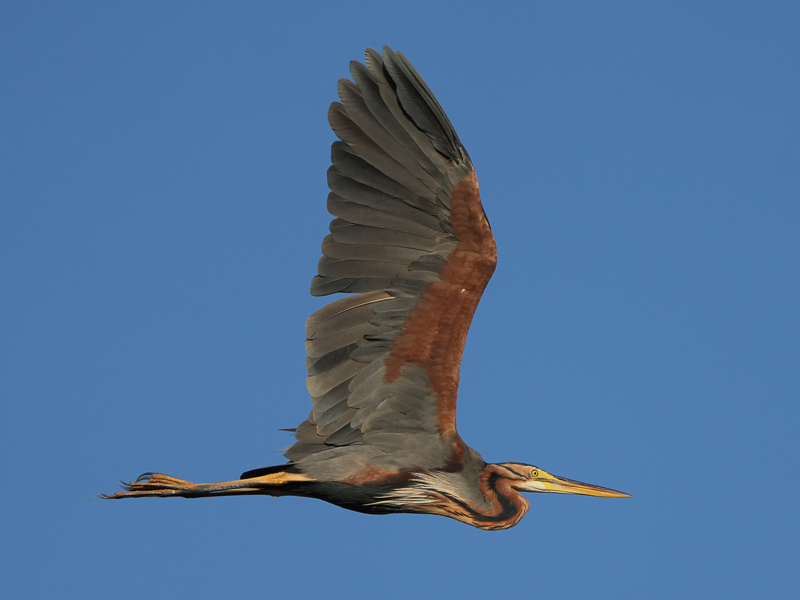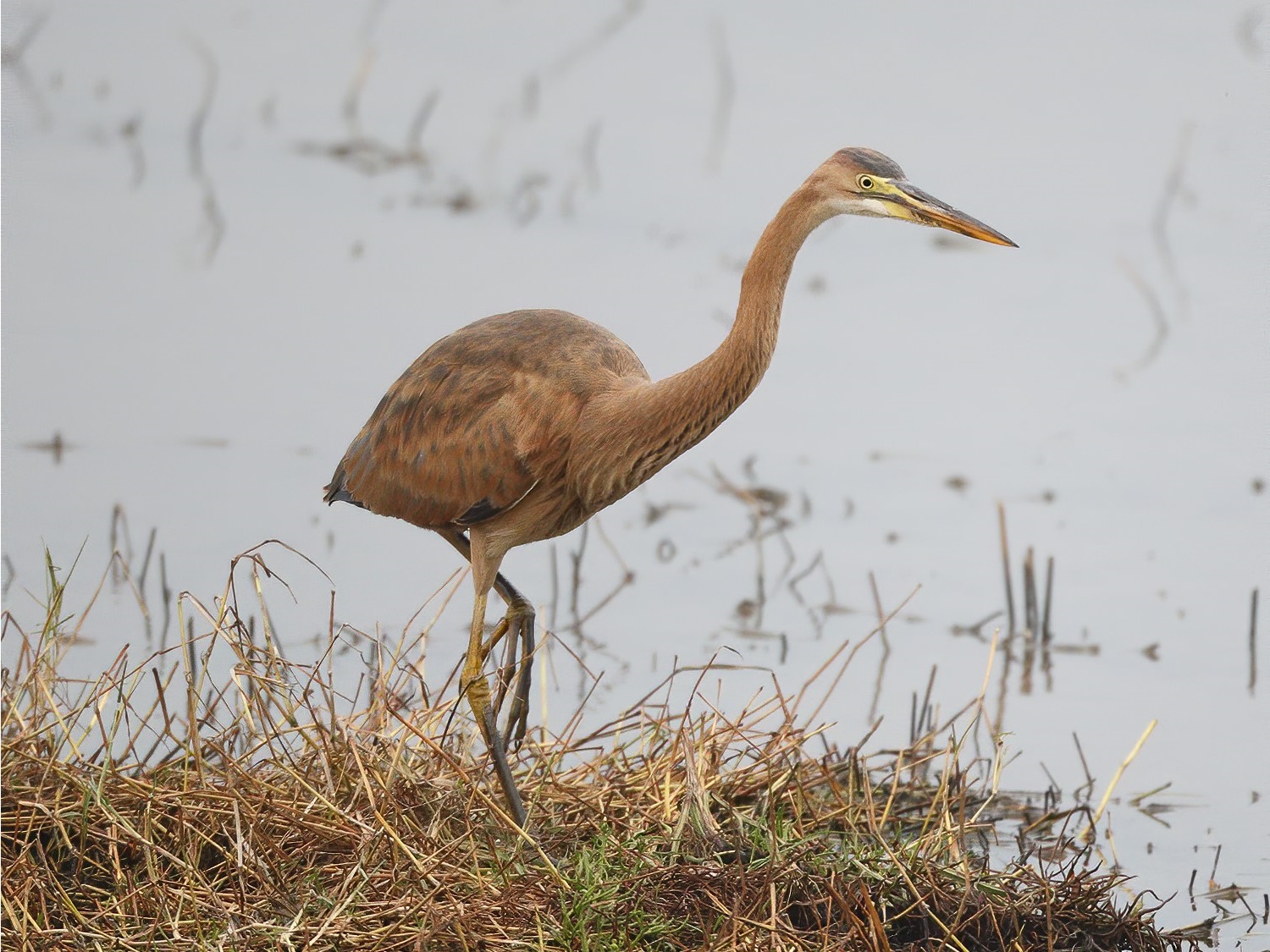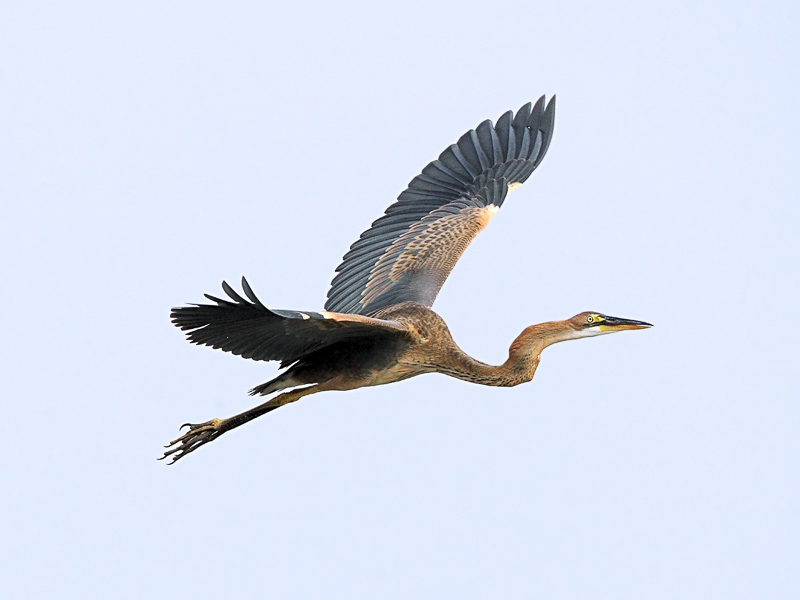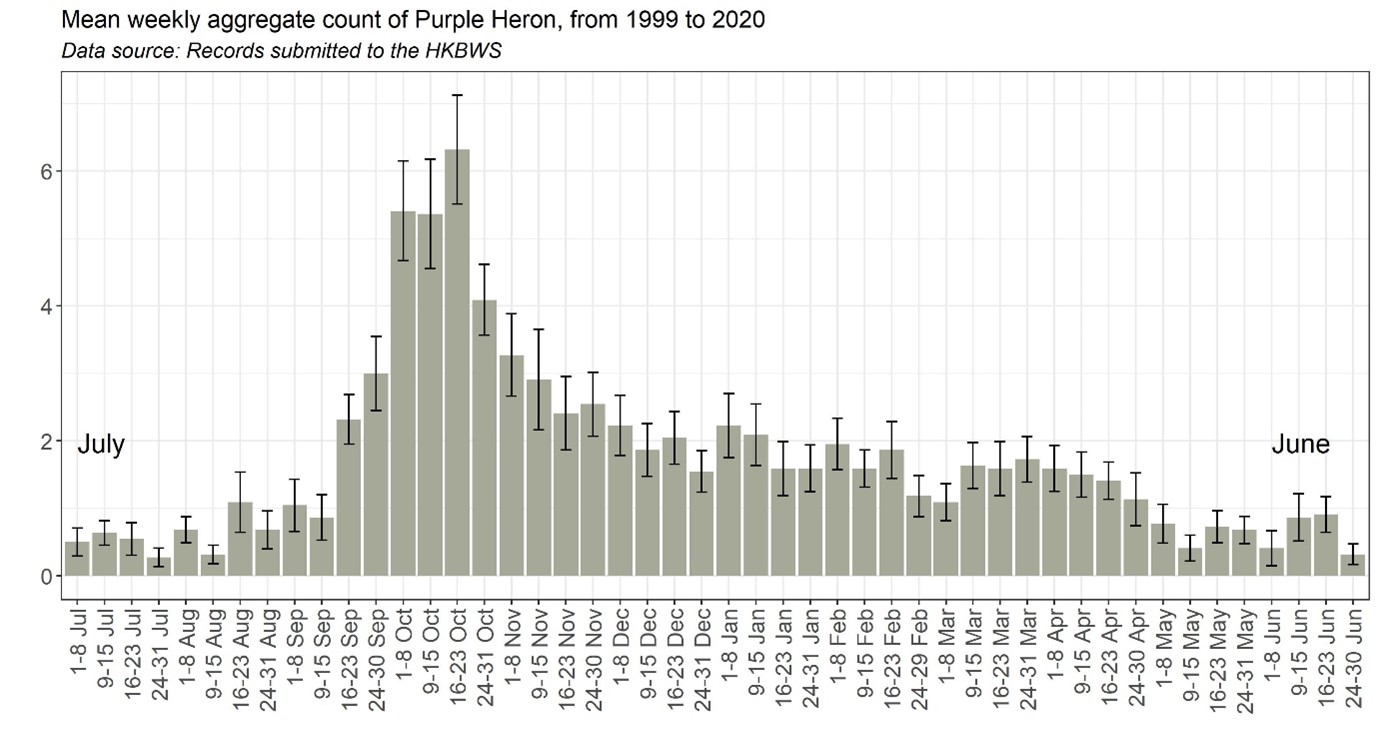Purple Heron Ardea purpurea 草鷺
Category I. Present all year in vegetated wetlands almost exclusively in the Deep Bay area. Most numerous during autumn passage. Peak counts have decreased since the early 1980s.
IDENTIFICATION

Jan. 2023, Wellington Ngai. Adult.
78-90 cm. Compared to Grey Heron, slightly smaller and leaner with a longer and narrower more pointed bill, smaller head with little angle between bill and forecrown, narrower neck and longer toes.
Adult plumage has rusty sides to head and neck with dark grey crown, nape plumes, moustachial stripe and lines running the length of the neck sides. Upperparts and wing coverts are largely greyish, the longer scapulars are rusty, and the bend of the wing is dark maroon.

Dec. 2022, Paul Leader. Adult.
In flight the underwing coverts of the adult are rich rusty-brown, while the length of the toes can be seen more easily.

Nov. 2012, Martin Hale. First-year.
Young birds are much more uniform, with head, neck, body and outer wing coverts rather plain buff brown and poorly-marked or absent dark lines on neck and head. Adult-like plumage begins to appear in the first autumn.

Oct. 2012, Michelle and Peter Wong. First-year.
In flight first-years are more uniform and less richly coloured than adults, and have dull greyish underwing coverts with a contrasting pale band.
VOCALISATIONS
Compared to Grey Heron, away from the breeding site calls are deeper and coarser but also slightly thinner. This recording begins with an alarm vocalisation when flushed but is followed by calls that are more typical of the relaxed flight call.
When flushed also gives a multi-call alarm vocalisation.
DISTRIBUTION & HABITAT PREFERENCE
Most records are from the Deep Bay area and the highest numbers occur in the reed beds at Mai Po, with other records coming from wet areas with tall vegetation. Most records away from the Deep Bay area have been of single birds during migration periods, primarily autumn, and most of these have occurred at Long Valley.
OCCURRENCE
Purple Heron is most numerous in autumn when it is a regular early morning sight at Mai Po NR. Figure 1 indicates that since 1999 main passage has occurred from the third week of September to mid-November, with peak numbers occurring in October. The highest count was 13 on 7 October 2015. In contrast, historically the highest counts are 50 on 11 October 1974 and 23 October 1982, and 20 on 5th and 25 September 1982, suggesting a decline has occurred.
Generally, one to four Purple Herons are recorded during the winter, though occasionally up to ten have been noted (mainly during the mid-1970s). Spring passage is much less marked than that in autumn, possibly beginning in the second week of March; numbers decline from the first week of April, and generally it is rare after the end of the month. The highest spring counts are 15 on 15 April 1978 and 11 April 1982, which compares with a high count of five since 1999.
Small numbers are recorded throughout the summer, generally five or fewer, but there were unusually high counts of 25 on 24 July 1979, 15 on 30 June 1984 and 13 on 6 July 1975. Since 1999 the highest summer count is eight, which included three nearly-fledged juveniles.
Vaughan and Jones (1913) stated that Purple Heron was ‘a rare winter visitor to some parts of the coast’ including Deep Bay. Dove and Goodhart (1955) noted it as a passage migrant, mainly in autumn. Macfarlane and Macdonald (1966) stated that it occurred throughout the year, though mainly on passage, and that there were very few summer records.
During the years 1974 to 1983 Purple Herons occurred in significantly higher numbers than have since been recorded, despite lower levels of observer coverage at that time. Given that the preferred habitat of reed beds has increased in area since then, it would seem a population decline has occurred.
BREEDING
Breeding in HK was long suspected but not proven, with juveniles, sometimes very young, occasionally reported from 7 May to 27 September. However, in 2013 and 2014 breeding was confirmed, though, so far, only in those two years. Nest-building or nest occupancy was reported from 16 April to 18 June and up to three fledged dependent juveniles were seen from 19th to 30 August. The nest was located at the edge of reed marsh among sedges, which were flattened and strengthened with branches broken off nearby trees.
BEHAVIOUR, FORAGING & DIET
Foraging appears to occur largely at night and early morning, and birds can be seen flying to diurnal roost sites in mangrove amid reed beds at Mai Po NR in the first half of the morning. Birds will often sit up and scan the area for a period of time both after arriving at the roost and before leaving later in the day. A solitary forager, defending territory by chasing off other birds.
Migrates both by day and night. Departing birds at dusk have been recorded from 14th to 28 April, including a flock of five, and during 17-31 October at Mai Po NR. In addition, one was seen over Tung Lung Chau migrating south by day with a flock of Grey Herons on 25 October 2021.
RANGE & SYSTEMATICS
Summer visitor to continental Europe, the Black and Caspian Sea areas, central Asia and east China largely between 30oN and 50oN; winters in sub-Saharan Africa, the Indian subcontinent, Indochina, south China and southeast Asia south to Indonesia (Martínez-Vilalta et al. 2020). In China a summer visitor to central, east and northeast areas, and a winter visitor to the southern coastal provinces, including Taiwan and Hainan (Liu and Chen 2020).
Four subspecies are recognised, of which A. p. manilensis breeds in south and east Asia to Philippines and Indonesia. The nominate occurs from Europe to the Middle East and Africa, while the remaining two are islands forms on Madagascar and Cape Verde Islands.
CONSERVATION STATUS
IUCN: Least Concern. Population trend decreasing.
Figure 1.

Dove, R. S. and H. J. Goodhart (1955). Field observations from the Colony of Hong Kong. Ibis 97: 311-340.
Liu, Y. and Y. H. Chen (eds) (2020). The CNG Field Guide to the Birds of China (in Chinese). Hunan Science and Technology Publication House, Changsha.
Macfarlane, A. M. and A. D. Macdonald, revised by Caunter, J. R. L. and A. M. Macfarlane (1966). An Annotated Check-list of the Birds of Hong Kong. Hong Kong Bird Watching Society, Hong Kong.
Martínez-Vilalta, A., A. Motis, and G. M. Kirwan (2020). Purple Heron (Ardea purpurea), version 1.0. In Birds of the World (J. del Hoyo, A. Elliott, J. Sargatal, D. A. Christie, and E. de Juana, Editors). Cornell Lab of Ornithology, Ithaca, NY, USA. https://doi.org/10.2173/bow.purher1.01
Vaughan, R. E. and K. H. Jones (1913). The birds of Hong Kong, Macao and the West River or Si Kiang in South-East China, with special reference to their nidification and seasonal movements. Ibis 1913: 17-76, 163-201, 351-384.

